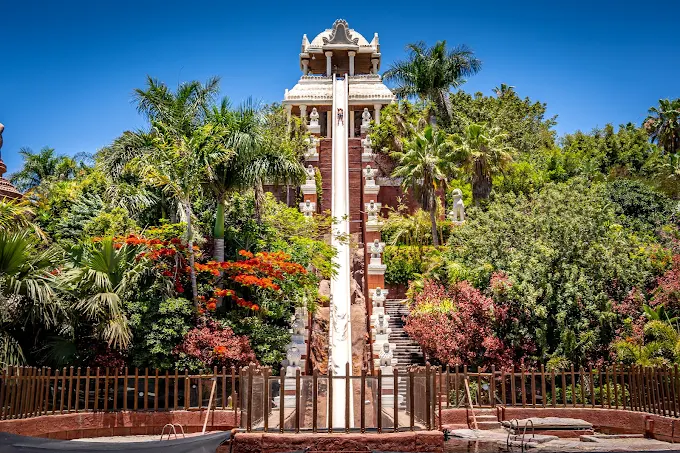For many travelers, a trip to Spain isn’t complete without a day at a water park.
If you spent childhood summers here, chances are you remember the wave pool knocking you flat, flipping your sibling’s inflatable in the lazy river, or staring down a towering kamikaze slide, wondering if it was really a good idea. And of course, you probably left with a peeling sunburn as a souvenir.
But while water parks feel like part of Spain’s DNA, they haven’t been around nearly as long as the country’s famous beaches and historic resorts. They arrived late, yet wasted no time in dominating the scene. In fact, Spain now leads the world in water park tourism—a title that, just a few decades ago, belonged firmly to the United States.
So where did it all begin? And which park can actually claim to be Spain’s first? Turns out, that’s a little more complicated than it seems.
Spain’s First Water Park? Depends Who You Ask
When it comes to naming the oldest water park in Spain, there’s no clear-cut answer. Three contenders stake a claim, each with its own version of history.
Aqualandia – The Iconic Name
Aqualandia in Benidorm is one of Spain’s most famous water parks, and it proudly calls itself the first. If you’ve ever taken a holiday in Benidorm, you’ve probably heard of it—it’s still a major attraction, drawing in visitors year after year.
The park itself acknowledges that water parks began in the U.S., with Wet ‘n Wild opening in Orlando in 1977. Aqualandia followed in 1985, becoming Europe’s largest water park at the time. Today, it’s no longer the biggest, but it still holds a record: home to Europe’s tallest water slide, the 33-meter-high Vertigo, which also happens to be the tallest capsule slide in the world.
Illa Fantasia – The Multi-Attraction Park
Another contender is Illa Fantasia, just outside Barcelona. Opened in 1981 by businessman Antonio Sarrià, it originally wasn’t just a water park. The place had paddle tennis courts, a bullring, and pools with slides, gradually expanding its water attractions over time.
The tricky part? Since it wasn’t a dedicated water park from day one, its claim to being the first is shaky at best.
Aquapark Torremolinos – The True First?
Digging deeper, one park seems to have the strongest case. A study by urban planning expert José Antonio Nombela Serrano states that he designed six of Spain’s first water parks, with the very first opening in 1984: Aquapark Torremolinos.
March 1984, to be exact. And interestingly, it wasn’t a Spanish project at all. It was developed by British company Themes International.
For its time, the park was cutting-edge. It had a 22-meter-high kamikaze slide, the tallest and fastest in Europe at the time. There was a wave pool, a lazy river—features that later became standard. Looking at the timeline, Aquapark Torremolinos seems to be Spain’s first true water park.

Spain Takes the Lead from the U.S.
Fast forward a few decades, and Spain isn’t just keeping up with the U.S.—it has surpassed it. And much of that is thanks to one park: Siam Park in Tenerife.
When it opened in 2008, Siam Park redefined what a water park could be. By 2014, it was ranked the world’s #1 water park by TripAdvisor, a title it held for an incredible ten years straight. Over 14 million visitors later, it remains the gold standard.
What sets Siam Park apart? The level of detail. It’s not just about slides and pools—it’s a full experience, with lush Thai-inspired theming and a mix of relaxation and heart-pounding thrills. Its signature ride, the Tower of Power, sends riders plummeting through a near-vertical drop—straight through an aquarium filled with sharks. It’s this kind of innovation that cemented Spain as a leader in water park tourism.
What’s Next for Spain’s Water Parks?
Water parks are now a major part of Spanish tourism, fueling local economies and constantly evolving. And in 2025, some new trends are shaping the future of these attractions.
Water Parks in Historic Settings – Spain is famous for its castles. Now, they’re getting a modern twist. One example is Don Juan de Valencia Castle in León, where the town hall decided to build a water park right outside. Is it to keep the kids entertained? Or is the water park the main draw, and the castle just a backdrop? Who knows. But with an interesting market of mansions and castles for sale in Spain (see here for example) we may see historic monuments modernised with water parks.
Water Parks for Dogs – Pet-friendly tourism is booming, and water parks aren’t just for humans anymore. The first dog-friendly water park opened in Roca del Vallès, Barcelona, and now similar parks exist in Alicante, Castellón, Ciudad Real, Madrid and Tenerife.
Themed Water Parks – Spain is taking inspiration from the U.S. by merging theme parks with water attractions. Parque Warner Beach in Madrid features Warner Bros. characters, while Western Water Park in Mallorca and Caribe Aquatic Park in Tarragona bring immersive experiences to visitors.
Floating Water Parks on the Coast – Beach towns are now offering massive inflatable water parks floating in the sea, evolving from simple inflatables to full-scale obstacle courses with paid entry. The Nautic Parc in Salou, Cambrils, and Miami Platja is a prime example of this trend.
Inflatable Water Parks on Land – Not all inflatable water parks are at the beach. A giant inflatable water park recently opened in Casar de Escalona, proving that even inland towns can get in on the action.
Spain’s love for water parks has come a long way from a few scattered slides in the ‘80s. Whether it’s record-breaking attractions, dog-friendly pools, or even water parks in historic castles, one thing is clear—the wave of innovation isn’t slowing down anytime soon.


